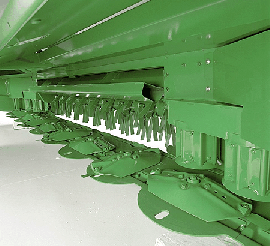The 995 Rotary Platform features a single conditioning option: the impeller conditioner.
Impeller conditioner
 Impeller conditioners
Impeller conditioners
The impeller conditioner works well in a wide variety of crop types and conditions. With proper adjustment, the impeller conditioner delivers a wide range of performance expectations to meet every producer's needs.
How an impeller conditioner works:
1. As hay is cut by rotating knives, 72 V-shaped tines pick up the plants and carry them through the machine. The free-swinging design reduces damage to the conditioner if rocks or other solid objects are struck.
- Tines are evenly spaced along the full width of the rotor
 Conditioning hood
Conditioning hood
2. As the plant passes through, it rubs against the conditioning hood (A) and other plants. The rubbing action removes the waxy surface from the stem of the plant to allow faster evaporation of moisture.
3. The conditioner hood is adjustable to control the conditioning intensity. The wider the opening, the less aggressive the conditioning; this is used in legume-type crops. The smaller the opening, the more aggressive the conditioning; this is used more in grass hay.
4. The impeller has two speeds to match crop conditioning requirements:
- Simply interchange the drive sheaves
- High speed of 865 rpm for grass hay
- Low speed of 624 rpm for legumes
The impeller conditioner works well in legumes, especially alfalfa and most all-grass crops. Impeller conditioners are not recommended for cutting thick-stemmed or cane-type crops over 1.5-m (5-ft) tall.
